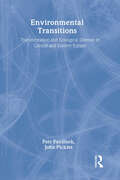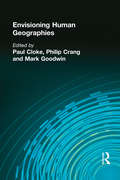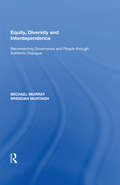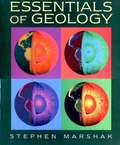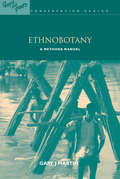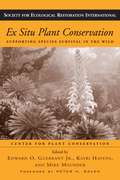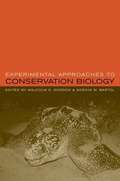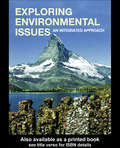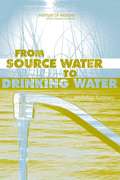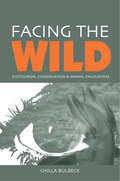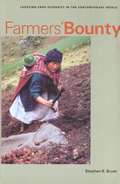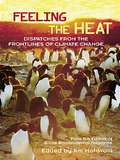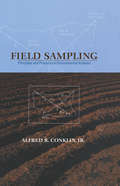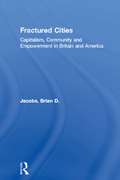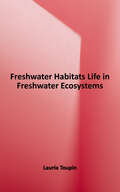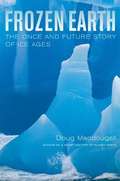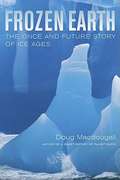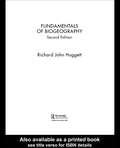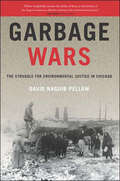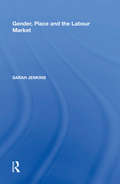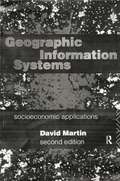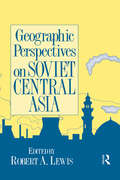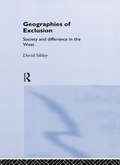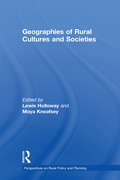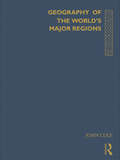- Table View
- List View
Environmental Transitions: Transformation and Ecological Defense in Central and Eastern Europe
by John Pickles Petr PavlínekEnvironmental Transitions is a detailed and comprehensive account of the environmental changes in Central and Eastern Europe, both under state socialism and during the period of transition to capitalism. The change in politics in the late 1980s and early 1990s allowed an opportunity for a rapid environmental clean up, in an area once considered one of the most environmentally devastated regions on earth. The book illustrates how transformations after 1989 have brought major environmental improvements, as well as new environmental problems. It shows how environmental policy, economic change and popular support for environmental movements, have specific and changing geographies associated with them. Environmental Transitions addresses a large number of topics, including the historical geographical analysis of the environmental change, health impacts of environmental degradation, the role of environmental issues during the anti-communist revolutions, legislative reform and the effects of transition on environmental quality after 1989. Environmental Transitions contains detailed case studies from the region, which illustrate the complexity of environmental issues and their intimate relationship with political and economic realities. It gives theoretically informed ideas for understanding environmental change in the context of the political economy of state socialism and post-communist transformations, drawing on a wide body of literature from West, Central and Eastern Europe.
Envisioning Human Geographies
by Paul Cloke Philip Crang Mark GoodwinBringing together many of the leading human geographers from around the English-speaking world, Envisioning Human Geographies offers a series of personal visions for the future of human geography. The result is a vigorous and far-sighted debate about what human geography could and should be concerned with in the twenty-first century.The individual contributors develop their arguments to address the shape and direction of human geographies, with each chapter looking forward and envisioning an intellectual future for the subject. The result is a set of powerful statements written around the themes of:·space·nature ·enclosure ·political-economy·non-representation ·post-colonialism ·feminism·post-structuralism ·computation·morality·spirituality ·activism. The statements are tied via an introduction that discusses the ideological, academic and aesthetic prompts that fire the human geographical imagination.Envisioning Human Geographies maps out important new territories of enquiry for human geography, and is essential reading for all students studying the nature and philosophy of the subject.
Equity, Diversity and Interdependence: Reconnecting Governance and People through Authentic Dialogue (Perspectives On Rural Policy And Planning Ser.)
by Michael MurrayIf civil society is being encouraged to more fully embrace inclusiveness and respect for diversity, then so must the multiplicity of service support organizations with which it interacts. This is the key proposition behind this seminal contribution to public policy. While legislation can ensure minimum standards of behaviour and outcomes, meaningful organizational progression beyond legal imperatives requires authentic dialogue, based on principles of equity, diversity and interdependence. These are essential components for deeper societal transformation. Using the divided society of Northern Ireland as a case study, and its rural governance arena in particular, this book provides an authoritative empirical analysis of, and prescriptive agenda for, collaborative conversations. The insights provided by this book go far beyond this region and have a profound relevance for other societies struggling to emerge from conflict, racism and social separation.
Essentials Of Geology
by Stephen MarshakIn this introductory textbook, Marshak (University of Illinois) incorporates the theory of plate tectonics and the concept of Earth science systems into discussions of rock types, volcanoes and earthquakes, crustal deformation and mountains, energy and mineral resources, water, ice, global change and other standard topics. Color photographs and diagrams illustrate the major ideas of the book, and a companion CD-ROM contains animated clips representing the processes described in the text.
Ethnobotany: A Methods Manual (People and Plants International Conservation)
by Gary J. MartinEthnobotany, the study of the classification, use and management of plants by people, draws on a range of disciplines, including natural and social sciences, to show how conservation of plants and of local knowledge about them can be achieved. Ethnobotany is critical to the growing importance of developing new crops and products such as drugs from traditional plants. This book is the basic introduction to the field, showing how botany, anthropology, ecology, economics and linguistics are all employed in the techniques and methods involved. It explains data collection and hypothesis testing and provides practical ideas on fieldwork ethics and the application of results to conservation and community development. Case studies illustrate the explanations, demonstrating the importance of collaboration in achieving results. Published with WWF, UNESCO and Royal Botanic Gardens Kew.
Ex Situ Plant Conservation: Supporting Species Survival In The Wild (Science Practice Ecological Restoration #3)
by Peter H. Raven Kayri Havens Center for Plant Conservation Edward O. Guerrant Michael MaunderFaced with widespread and devastating loss of biodiversity in wild habitats, scientists have developed innovative strategies for studying and protecting targeted plant and animal species in "off-site" facilities such as botanic gardens and zoos. Such ex situ work is an increasingly important component of conservation and restoration efforts. Ex Situ Plant Conservation, edited by Edward O. Guerrant Jr., Kayri Havens, and Mike Maunder, is the first book to address integrated plant conservation strategies and to examine the scientific, technical, and strategic bases of the ex situ approach. The book examines where and how ex situ investment can best support in situ conservation. Ex Situ Plant Conservation outlines the role, value, and limits of ex situ conservation as well as updating best management practices for the field, and is an invaluable resource for plant conservation practitioners at botanic gardens, zoos, and other conservation organizations; students and faculty in conservation biology and related fields; managers of protected areas and other public and private lands; and policymakers and members of the international community concerned with species conservation.
Experimental Approaches to Conservation Biology
by Malcolm S. Gordon Soraya M. BartolEnvironmental and biological researchers from around the world present a selection of current case studies relevant to protecting world biodiversity that illustrate issues in both basic and applied experimental biology, at a level accessible to students and non scientists as well as active researcher. The also want to raise the visibility of organism-centered experimentation as a valid and useful approach to conservation biology, and to narrow the gap that divides researchers from managers and policymakers charged with protecting biodiversity. The 18 selected papers were to be presented a September 2001 conference in Los Angeles, but some were not delivered because air traffic was closed and authors could not reach Los Angeles. Annotation ©2004 Book News, Inc., Portland, OR (booknews.com)
Exploring Environmental Issues: An Integrated Approach
by David D. KempGlobal warming, ozone depletion, drought, acid rain - their causes are viewed as extraordinarily complex; their effects are assumed catastrophic. Exploring Environmental Issues provides a key to understanding our potential crisis. The concise, introductory text presents a review of current environmental issues using a geographical approach that stresses the interrelationships between environment and societies.This user-friendly volume is an essential book for students and all who are concerned with the nature of contemporary environmental issues. Information is presented in a refreshing manner utilising over 170 figures and 50 photographs. Global boxed case studies are used throughout to highlight and explore issues in more detail. The text also contains discussion points, annotated further reading and an extensive glossary.
FROM SOURCE WATER TO DRINKING WATER: Workshop Summary
by Medicine Research Roundtable on Environmental Health SciencesInformation on the movement from source water to drinking water
Facing the Wild: Ecotourism, Conservation and Animal Encounters
by Chilla BulbeckWhat do wild animals mean to humans? Will they survive both rampant habitat loss and extinction caused by human encroachment and, as ecotourists, our enthusiasm for them? With ecotourism now the fastest growing segment of tourism, and encounters with wild animals - be it swimming with dolphins, going on safari or bird watching - ever more popular, these are critical questions. Yet until now little has been known about why people crave encounters with wild animals and the meaning for the ecotourism industry, conservation efforts and society at large. Facing the Wild is the first serious empirical examination of why people seek out animals in their natural environment, what the desire for this experience tells us about the meanings of animals, nature, authenticity and wilderness in contemporary industrialized societies, and whether visitors change their environmental perspectives and behaviour, as the custodians of wildlife parks would like them to. The book explores the contradictions and ambivalence that so many people experience in the presence of 'wild nature' - in loving it we may diminish it and in the act of wanting to see it we may destroy it. Ultimately the book makes a case for 'respectful stewardship' of a 'hybrid nature' and provides insight for both practitioners and ecotourists alike.
Farmers' Bounty: Locating Crop Diversity in the Contemporary World
by Stephen B. BrushOver the course of generations, pre-industrial human agriculture left a bounty of crop diversity across the earth. Bringing together a quarter century of research on the subject and his own field work in the Peruvian Andes, Mexico, and Turkey, Brush (agricultural and environmental science, U. of California at Davis) investigates questions related to patterns of agricultural crop diversity, the impact of farming changes such as industrialization, and methods of conserving diversity. He looks at the questions through lenses of evolutionary science and anthropological ethnobiology. Central to the discussion is the notion of genetic erosion, and Brush discusses both likely causes and possible policy solutions. Annotation ©2004 Book News, Inc. , Portland, OR (booknews. com)
Feeling the Heat: Dispatches from the Front Lines of Climate Change
by From the Editors of E/The Environmental MagazineFor an increasing number of people, global warming is not an academic and scientific debate, but a matter of survival. As the planet warms at a rate of four degrees Fahrenheit per century, violent storms are increasing in frequency, icebergs are melting, sea level is rising, species are losing their habitats, and temperature records are being broken. Feeling the Heat consists of chapter-length visits by well-known authors to actual world "hot" spots, where people are already coping day-to-day with the consequences of climactic disruption. The locations for the book were strategically chosen because each represents a separate and important global warming impact, such as rising tides, melting glaciers, evolving ecosystems and air pollution. Feeling the Heat takes global warming out of the realm of armchair speculation and arcane scientific debate, revealing the process of climate change to be ongoing, serious and immediate.
Field Sampling: Principles and Practices in Environmental Analysis (Books in Soils, Plants, and the Environment)
by Alfred R. Conklin Jr.Written by a renowned professional with more than 30 years of experience in environmental sampling and analysis, this reference describes in unparalleled detail all the essential elements for the development and execution of a successful sampling plan at both contaminated and uncontaminated sites. The book covers presampling planning and decision-making, specific sampling situations, and correct sample labeling, and presents the framework and background for the sampling of any contaminated site. Presenting a wide variety of models, quality control procedures, and valuable troubleshooting methods, Field Sampling contains an abundance of topics never before covered in any other source.
Fractured Cities: Capitalism, Community and Empowerment in Britain and America
by Brian D. JacobsAnglo-American cities face economic decline, social polarisation and racial conflict. Their fate is increasingly decided by the global actions of transnational corporations and market forces. Community groups find it difficult to gain access to the political system. Ethnic minorities strive for empowerment while indebted city governments battle to maintain basic services. Such is the urban crisis of the 1990s. Fractured Cities describes the political economy of urban change and explores the future of the city.
Freshwater habitats : life in freshwater ecosystems
by Laurie ToupinA look at the plants, animals, locations, and various habitats that make up the freshwater ecosystems of the world.
Frozen Earth: The Once and Future Story of Ice Ages
by Douglas MacdougallDoug Macdougall explores the causes and effects of ice ages that have gripped our planet throughout its history, from the earliest known glaciations -- nearly three billion years ago -- to the present.
Frozen Earth: The Once and Future Story of Ice Ages
by Doug MacdougallIn this engrossing and accessible book, Doug Macdougall explores the causes and effects of ice ages that have gripped our planet throughout its history, from the earliest known glaciation--nearly three billion years ago--to the present. Following the development of scientific ideas about these dramatic events, Macdougall traces the lives of many of the brilliant and intriguing characters who have contributed to the evolving understanding of how ice ages come about. As it explains how the great Pleistocene Ice Age has shaped the earth's landscape and influenced the course of human evolution, Frozen Earth also provides a fascinating look at how science is done, how the excitement of discovery drives scientists to explore and investigate, and how timing and chance play a part in the acceptance of new scientific ideas. Macdougall describes the awesome power of cataclysmic floods that marked the melting of the glaciers of the Pleistocene Ice Age. He probes the chilling evidence for "Snowball Earth," an episode far back in the earth's past that may have seen our planet encased in ice from pole to pole. He discusses the accumulating evidence from deep-sea sediment cores, as well as ice cores from Greenland and the Antarctic, that suggests fast-changing ice age climates may have directly impacted the evolution of our species and the course of human migration and civilization. Frozen Earth also chronicles how the concept of the ice age has gripped the imagination of scientists for almost two centuries. It offers an absorbing consideration of how current studies of Pleistocene climate may help us understand earth's future climate changes, including the question of when the next glacial interval will occur.
Fundamentals of Biogeography (Routledge Fundamentals of Physical Geography)
by Richard John HuggettFundamentals of Biogeography presents an accessible, engaging and comprehensive introduction to biogeography, explaining the ecology, geography, history and conservation of animals and plants. Starting with an outline of how species arise, disperse, diversify and become extinct, the book examines: how environmental factors (climate, substrate, topography, and disturbance) influence animals and plants; investigates how populations grow, interact and survive; how communities form and change; and explores the connections between biogeography and conservation.The second edition has been extensively revised and expanded throughout to cover new topics and revisit themes from the first edition in more depth. Illustrated throughout with informative diagrams and attractive photos and including guides to further reading, chapter summaries and an extensive glossary of key terms, Fundamentals of Biogeography clearly explains key concepts in the history, geography and ecology of life systems. In doing so, it tackles some of the most topical and controversial environmental and ethical concerns including species over-exploitation, the impacts of global warming, habitat fragmentation, biodiversity loss and ecosystem restoration.
Garbage Wars: The Struggle for Environmental Justice in Chicago (Urban and Industrial Environments)
by David Naguib PellowA study of the struggle for environmental justice, focusing on conflicts over solid waste and pollution in Chicago.In Garbage Wars, the sociologist David Pellow describes the politics of garbage in Chicago. He shows how garbage affects residents in vulnerable communities and poses health risks to those who dispose of it. He follows the trash, the pollution, the hazards, and the people who encountered them in the period 1880-2000. What unfolds is a tug of war among social movements, government, and industry over how we manage our waste, who benefits, and who pays the costs.Studies demonstrate that minority and low-income communities bear a disproportionate burden of environmental hazards. Pellow analyzes how and why environmental inequalities are created. He also explains how class and racial politics have influenced the waste industry throughout the history of Chicago and the United States. After examining the roles of social movements and workers in defining, resisting, and shaping garbage disposal in the United States, he concludes that some environmental groups and people of color have actually contributed to environmental inequality.By highlighting conflicts over waste dumping, incineration, landfills, and recycling, Pellow provides a historical view of the garbage industry throughout the life cycle of waste. Although his focus is on Chicago, he places the trends and conflicts in a broader context, describing how communities throughout the United States have resisted the waste industry's efforts to locate hazardous facilities in their backyards. The book closes with suggestions for how communities can work more effectively for environmental justice and safe, sustainable waste management.
Gender, Place and the Labour Market
by Sarah JenkinsAlthough research on the labour market has remained central to the development of work on gender in geography, there has been an absence of texts on the importance of space in relation to employment. This volume explores the geography of women's participation in the UK labour market and centres on the importance of work-home interdependencies and factors which both influence women's decision-making processes and contribute to the formation of their perceived societal role. The book draws on interviews with individual women about the influential factors in deciding whether or not they participate in the formal labour market. It highlights the importance of social and cultural factors in addition to the availability of jobs in the local economy in influencing labour market participation. It also compares the choices the Government claims to provide with the choices individual women feel they have when it comes to negotiating their everyday lives.
Geographic Information Systems: Socioeconomic Applications
by David MartinThis second edition of Geographic Information Systems builds on the strengths of the first, and incorporates important recent advances in GIS development and major new socioeconomic datasets including new census data. Martin presents an accessible introduction to the history, principles and techniques of GIS, with a unique focus on socioeconomic applications. This non-technical volume addresses the needs of students and professionals who must understand and use GIS for the first time.
Geographic Perspectives on Soviet Central Asia
by Robert A. LewisIn a unique survey, based on new census data, Geographic Perspectives on Soviet Central Asia highlights the region's geographic, economic and ecological problems since 1945. Painting a grim picture, this book investigates how the combination of rapid population growth and declining per capita investment is causing economic conditions to slide in rural areas and encouraging an ecological catastrophe. The authors discuss the effects of low rural out-migration, and show that at current growth rates the rural working-age population will double with each generation. Unprecedented in a developed country, this is causing the region to become more rather than less rural. Soviet Central Asia is an area of low productivity, and the book considers the lack of support from Soviet central government to the region. Wishing to maximise their return to capital and labour, the government is concentrating its investment in the European West and directing insufficient funds for a growing workforce in Central Asia. Soviet Central Asia also faces grave ecological problems; the declining level of the Aral Sea, extensive soil salinization and water pollution, all largely due to past attempts at irrigation. The authors consider the effect of these disasters on the area, and look to future possibilities in this very important region of the world.
Geographies of Exclusion: Society and Difference in the West
by David SibleyImages of exclusion characterised western cultures over long historical periods. In the developed society of racism, sexism and the marginalisation of minority groups, exclusion has become the dominant factor in the creation of social and spatial boundaries. Geographies of Exclusion seeks to identify the forms of social and spatial exclusion, and subsequently examine the fate of knowledge of space and society which has been produced by members of excluded groups. Evaluating writing on urban society by women and black writers the author asks why such work is neglected by the academic establishment, suggesting that both practices which result in the exclusion of minorities and those which result in the exclusion of knowledge have important implications for theory and method in human geography. Drawing on a wide range of ideas from social anthropology, feminist theory, sociology, human geography and psychoanalysis, the book presents a fresh approach to geographical theory, highlighting the tendency of powerful groups to purify' space and to view minorities as defiled and polluting, and exploring the nature of difference' and the production of knowledge.
Geographies of Rural Cultures and Societies (Perspectives on Rural Policy and Planning)
by Moya KneafseyThe last decade or so has witnessed a flourishing of research in rural geography; in particular, approaches which have developed socio-cultural perspectives on rural issues. This book brings together well-established and newer researchers to examine the position of rural social and cultural geography at the beginning of the 21st century and to suggest new research agendas. It offers critical evaluations of theoretical positions and advances, introduces new conceptual and methodological tools and reports on recent empirical work on a variety of topical issues in a number of countries. With diverse theoretical and empirical content, the book makes a valuable contribution to the development of research into changing social and cultural geographies of rurality in 'developed' or 'Western' countries.
Geography of the World's Major Regions
by John ColeThis volume presents a global view of today's most pressing issues through an analysis of the twelve major regions of the world. Environmental degradation, natural catastrophe, population pressures and human conflict all impact in different ways and to different degrees on the society and environment of these regions. Economic and political restructuring within each region is covered, and topics include: natural resources; agriculture; industry and services; the role of the military; and the impact of global economic change. This work is intended as an introduction for students studying the changing geography of the world, but should also provide a useful overview to students researching specific regions, seeking comparative analysis of regions, or following general courses on the economic and political geography of both the post-industrial and the developing worlds. Over 250 photographs, maps and figures complement a range of boxed case-studies, key points, questions and guides to further reading.
